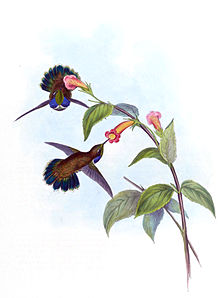Geoffroy's daggerbill
| Geoffroy's wedgebill | |
|---|---|

| |
| Scientific classification | |
| Domain: | Eukaryota |
| Kingdom: | Animalia |
| Phylum: | Chordata |
| Class: | Aves |
| Clade: | Strisores |
| Order: | Apodiformes |
| Family: | Trochilidae |
| Genus: | Schistes |
| Species: | S. geoffroyi
|
| Binomial name | |
| Schistes geoffroyi Bourcier, 1843
| |

| |
| Synonyms | |
|
Augastes geoffroyi (Bourcier, 1843) | |
Geoffroy's daggerbill, Geoffroy's wedgebill or eastern wedge-billed hummingbird (Schistes geoffroyi) is a species of hummingbird in the family Trochilidae. It is sometimes merged with the visorbearers in Augastes. It has been split from the white-throated daggerbill by most taxonomic authorities. Some authorities calling them the wedge-billed hummingbird.
It is found in Bolivia, Colombia, Ecuador, Peru, and Venezuela. Its natural habitat is subtropical or tropical moist montane forest.
Ecology

Geoffroy's daggerbills typically reside in the understory of cloud forest interiors, with preference to areas containing thick moss, ravines, and thick undergrowth.
Contrary to its name, it can be difficult to identify using only its bill characteristics. It's typically found in solitude and possesses a white stripe behind the eye, white tufts on the chest, a rounded tail, and a short bill.
Like most hummingbirds, it feeds primarily on flower nectar, mainly by piercing the base of the flower.[2]
References
- ^ BirdLife International (2012). "Schistes geoffroyi". IUCN Red List of Threatened Species. 2012. Retrieved 26 November 2013.
{{cite journal}}: Invalid|ref=harv(help) - ^ "Overview - Wedge-billed Hummingbird (Schistes geoffroyi) - Neotropical Birds". neotropical.birds.cornell.edu. Retrieved 2016-03-30.

